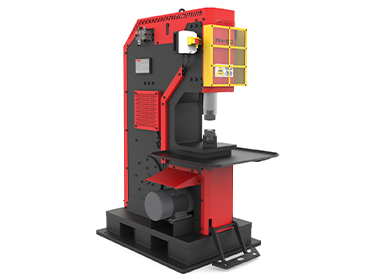Power Hammers
MP NARGESA power hammers or trip hammers are made from welded and machined steel sheet. They are used in many smithies to manufacture all kinds of pieces for ornamental forging, facilitating the work of shaping hot iron. Using different tools, they upset, shape, cut, punch, rivet, stamp, etc., all types of metals.
Frequently Asked Questions about NARGESA Forging Power Hammers
How does the striking system work in Nargesa power hammers?
The Nargesa Hammers are built with two twin pistons, a rear one driven by a cam and a pulley via an electric motor that turns it into a compressor. In this way, air is saved, and the machine itself produces it.
They also have a front piston responsible for moving the ram up and down in a controlled manner.
The pistons are connected through a valve that controls movement and stroke. This system is the most complex but also the most effective and precise when working.
What are the advantages of welded and machined steel plate construction compared to cast models?
In the past, most hammers were made of cast iron, and the main problem was the cracks that appeared in some models, which were very difficult to repair.
At Nargesa, from the beginning, it was clear: welded steel frame, much stronger, designed to prevent cracks or fissures during use.
What types of operations can be performed with Nargesa power hammers, and what additional tools are compatible?
The applications are endless; as the name suggests, it’s a hammer, but with much more force than the operator has to exert directly.
There are cold applications, such as marking, shaping, or imitating antique pieces, and hot applications, such as riveting, punching, forge welding, compressing iron, cutting, bending, changing shape and thickness until the desired form is achieved, etc.
Thanks to a mounting system with support blocks, all the tools a blacksmith can make are compatible with the Nargesa PH50 hammer.
The best material used for making tools is steel 1.2344 / AFNOR: Z40CDV5 / DIN: X40CrMoV5-1 / UNE: F5318 / AISI: SAE H13 / SKD61 / 45Cr5MoSiV. It is a steel for hot work without damaging the tooling or dies. However, it is possible to manufacture tools from any type of steel with subsequent treatment.
What maintenance and safety considerations should be taken into account when operating Nargesa power hammers?
Maintenance is minimal: keep the self-lubrication oil reservoir full and check the belt tension twice a year.
There are several safety features on Nargesa hammers:
- Mechanical drive lever that locks all machine movement to allow safe mold changes.
- In case of a malfunction, the Nargesa hammer is designed so that the front ram descends very slowly, without causing any damage.
- Adjustable front guard to prevent direct projections toward the operator.
- Emergency stop
What is the difference between a double-action and a single-action power hammer?
Single-action hammers are normally driven by a cam or other system that lifts the weight and releases it without control, while double-action hammers are pneumatically driven and the operator has full control of the descent.
Single-action hammers were very popular in the past and used for many applications, such as grinding grain, but not for metal.
How does air pressure affect the power and speed of the blow in Nargesa power hammers?
The hammer’s power depends mainly on the ram weight and also on its actuation speed. That is why double-action hammers with an integrated air compressor are much more efficient than single-action ones.
What types of materials can be worked with Nargesa power hammers?
All types of ferrous materials can be worked: brass, bronze, gold, silver, etc. The most common is iron or steel of different grades. The most common working method is hot, either in a coal forge, induction, or gas furnace.
What is the lifespan of a Nargesa power hammer, and what factors influence its durability?
The hammer was invented in the 14th century and used to grind grain and crush stones. Later, in the 19th century, it revolutionized industry by working iron and increasing productivity. It is a very old machine that has continued to evolve.
Nargesa hammers can last generations. They are overbuilt machines and very simple to manufacture.
Currently, some hammers made in the 1960s and 1970s are still in operation without any issues.
How do Nargesa power hammers compare to other forging systems, such as hydraulic presses?
Power hammers deliver consecutive impacts with relatively low force.
In contrast, the hydraulic press descends much more slowly but exerts much greater force, reaching thousands of tons.
Each machine has a different application. In most cases, many clients have both machines to increase production.
Join to our Newsletter
Be part of our Nargesa Community and get all information of the branch, demo clips, campaigns in Machinery…















